Amal Rantisi | Khaled al-Jeratli | Hussam al-Mahmoud
The Syrian regime has been tracking former opposition areas by Russian-brokered settlement deals, starting from Daraa and Damascus in southern Syria to Aleppo in the north, and Deir Ezzor and Raqqa in the east. In addition, Damascus is pushing for security agreements with former fighters, army defectors, deserters who preferred to stay in their districts and refused evacuation, or young men who escaped military conscription.
Daraa governorate blew up the settlements’ bubble last summer when Bashar al-Assad’s forces and allied militias launched a military campaign to storm Daraa al-Balad, the economic hub of the southern province, resulting in a two months blockade in the first escalation since a Russian-arranged settlement was reached in 2018.
The escalation ended by imposing new settlements in September 2021, which included an array of towns in the Daraa countryside, while new settlements were initiated in Deir Ezzor, followed by Raqqa and the countryside of Aleppo and Damascus.
The areas in which settlements take place are ruled by field datums and de-facto authorities that differ from one city to another in light of the presence of influential international players in the Syrian conflict.
The so-called settlement deals are based on the principle of reconciliation while the conflict factors remain, such as the political regime’s survival, military hegemony, banning political parties, civil society, and suppression of freedoms.
Enab Baladi will dig inside recent settlement agreements and examine the factors that control each region, in addition to diagnosing the relationship between field settlements and the political settlements. It will also view analysis by experts and researchers on the sociological and political impacts to scope the Syria future.
Successive settlements
The reconciliation deals followed major Russian-led offensives and severe sieges on the opposition-held towns and cities like what happened in the old neighborhoods of central Homs city in May 2014. Then in Damascus and the eastern neighborhoods of Aleppo in 2016, and then Eastern Ghouta suburbs near the capital and southern Daraa province in 2018.
In the meantime, the regime’s settlements have been characterized in new shape as no siege or military operation, benefiting from the desire of the former opposition fighters to reintegrate to continue their lives in a normal way to secure a living or taking advantage of wanted people who fed up the state of escape.
The settlements have even taken place in areas that overlap with the US-backed Syrian Democratic Forces (SDF) in northeastern Syria.
Subjugating southern Syria
In the cradle of the Syrian revolution, Daraa, the settlements have included the province center and the towns of the western, northern, and eastern countryside over the past two years. The regime’s Security and Military Committee resumed reconciliation deals in January 2022.
Former armed opposition commanders, who agreed on settlements and remained in Daraa, described to Enab Baladi the series of settlements as mere cosmetic operations to stop further armed clashes in the south.
The Quneitra province, at the line of the Israeli-Occupied Golan Heights, has also witnessed a number of settlements and security deals, including the evacuation of former fighters towards northern Syria in June of 2021.
The settlements in Daraa and Quneitra ended with the regime forces imposing almost complete military control over southern Syria, but they did not bring about any change in the security, living, and service levels.
Near SDF strongholds
Since the beginning of November 2021, the Syrian regime forces have started promoting security settlements in the Deir Ezzor governorate through Baathist party leaders.
The party’s cadres held a meeting on 9 November, during which Baathist leaders spoke of what they called an “honorable gesture” from the head of the regime, Bashar al-Assad, for a general “settlement” for the people and “national reconciliation” processes, including wanted people and deserters from compulsory service.
The Deir Ezzor settlements were established in several centers and villages, starting with the governorate center, passing through the cities of al-Mayadin and al-Bukamal, east of Deir Ezzor, to settle in the village of al-Shamitiyeh, which is a few kilometers away from the areas of influence of the SDF supported by the International Coalition in northeastern Syria.
These settlements were rejected by the Kurdish-led forces (SDF), as the deputy co-chair of the Executive Council in the Autonomous Administration, the political wing of the US-backed forces, Amina Ossi, said that the settlements target the social fabric in the region, adding that Damascus has tried and is still trying to strike the stability of the areas run by the Autonomous Administration of North and East Syria (AANES). “Announcing the start of settlements is one such attempt,” Ossi added.

A group of people in the settlement center in the village of al-Shamitiyeh, west of Deir Ezzor – 3 January 2022 (SANA)
Raqqa: Popular rejection
The regime’s announcement in early 2022 to begin settlement deals in northeastern Raqqa province angered local residents, as Raqqa was the first city to break out of the regime’s control nearly nine years ago when it fell to the control of the Islamic State (IS) before being liberated in 2017 by Kurdish-led Syrian forces.
In a statement, Raqq’s tribal figures rejected the start of settlement deals, considering them a direct threat to the stability of the city and its countryside, according to the local North Press Agency.
The SDF-controlled areas of Raqqa witnessed numerous protests and demonstrations in protest of the settlements that the regime started in its few areas of influence in the countryside of Raqqa.
The Syrian regime forces and allied Iranian militias control several areas in Raqqa, such as the town of Rusafa, south of Mansoura city, 30 km west of Raqqa, and the towns of Ma’dan and al-Sabkha, and its villages in the southeastern countryside, while the SDF controls most of the province, except the northern areas which are under the control of the Turkish-backed Syrian National Army (SNA).
Damascus and Aleppo: No timeline
The security settlements made in Damascus countryside have included the towns of Moadamiyet al-Sham and Darayya in the western suburbs. The majority of these areas’ residents had previously been displaced in 2018 following a major offensive.
Member of the People’s Assembly, Abdulrahman al-Khatib, told pro-regime Sham FM radio, on 8 February, that the security committee concerned with the settlement process in the suburbs of Damascus began in Moadamiyet al-Sham, days after announcing its launch in the Kiswa town south of the capital.
Although the Syrian regime announced that the duration of these settlements is one day, they usually extend for days and sometimes weeks, as was the case in Moadamiyet al-Sham.
Al-Khatib said that the settlements did not have a timeline but that the move would be made to al-Tal’s city and neighboring villages, Eastern Ghouta district, towns of Zabadani and Yabroud, the villages of Wadi Barada, and the Eastern Qalamoun towns.
On 9 February, the settlement deals moved to the town of Maskanah in Aleppo province near the SDF’s areas of control, according to the state-run Syrian News Agency (SANA).
SANA accused the SDF and Turkish-backed SNA in the northern Aleppo countryside of trying to hinder settlement deals.
A step towards stability or new divisions?
Citizens plunge into despair amid entrenching tyranny
The settlement process collided with popular rejection due to the regime’s continuation of arrests amid a complete security grip in areas where the reconciliations took place.
One of the notable figures in Daraa, who spoke to Enab Baladi on the condition of anonymity, said that local residents are not taking settlement agreements seriously as most of them feel unsafe to pass at the regime’s checkpoints for fear of arbitrary arrest.
Mustafa al-Abdullah, a senior figure of the al-Afadilah tribe, Raqqa’s largest clan, told Enab Baladi that the Syrian regime is “throwing ashes in the eyes, such a metaphorical phrase to indicate to the regime’s seek to cloak the truth with falsehood, by announcing the start of settlements, whether in Raqqa or Deir Ezzor.
Al-Abdullah added that hundreds of thousands of people in Raqqa fear the return to the Syrian regime ‘bosom’ because they know very well the extent of its criminality. “So how can these people be safe from the side of the regime and make settlements,” he added.
In Deir Ezzor, some residents whom Enab Baladi contacted considered that “the settlement procedure will protect them from the regime’s viciousness” in the event that the reality of control in Deir Ezzor changes, whether through military battles or within understandings with the SDF.
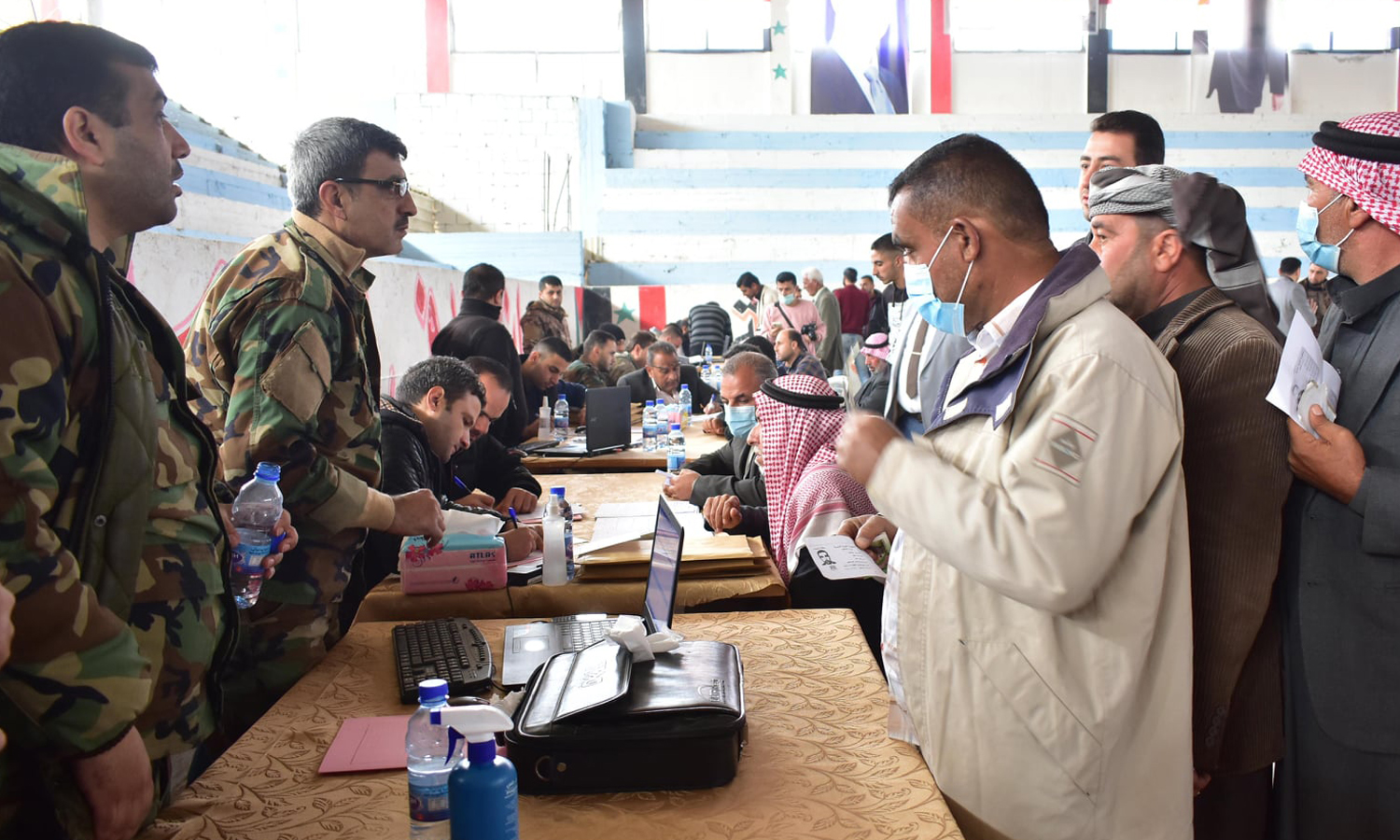
Part of the settlement agreements carried out by the regime forces in Deir Ezzor’s Sports Hall – 14 November 2021 (Facebook / Baath Party Division in Deir Ezzor)
Are settlement deals stability supportive?
In regard to the social impact of settlement deals and their reflection on the demographic population and the social stability, Maan Talaa, a researcher at the Omran Center for Strategic Studies, believes that the settlements had lucid effects on the societal structure, as it contributed to the sustainable absence of any local roles, which in turn was accompanied by the government failure in producing an unstable security environment in which the rates of crimes, theft, kidnappings, arrests, and others increase.
The regime has deepened the state of local despair through the lack of the idea of emergence and exit from the authoritarian state to a state that guarantees people’s dignity and their decent living through settlements, as well as ensuring their participation in the decision-making process and its implementation, Talaa told Enab Baladi.
This accumulation, in the end, contributed to the transformation of the Syrian citizen from a productive citizen to a consumer citizen. In these settlements, citizens intend to turn into something incapable of action, which naturally threatens Syria’s social fabric.
Talaa added that the settlements contributed to the emergence of sharp societal divisions between the people themselves, as the supportive class reappeared, while the public class is a class that is still governed by fear of the security services, political work, and involvement in any civil work, according to the researcher.
Accordingly, it contributed to the return of the constitutional rules imposed by the Syrian security services. The constitution for the people is what the security services and their networks say, and the security services’ compass is still the one through which the citizen knows the limits of what is permitted and what is prohibited.
The other effect was the revival of the old regime networks that control the scene, including Baathists, local mediators, beneficiaries, and men on which the regime relies on some societal issues, Talaa says.
The researcher of the Omran Center for Strategic Studies assures that the social transformation brought about by the revolution has been aborted by the regime today by restoring the old “dynamics” that control the scene, which says that there is a police state, and people are living under this police state, without having any ambition.
Aron Lund, a researcher on Syria at the Swedish Defense Research Agency (FOI), believes that “fundamentally, any advance for the Syrian government will create insecurity for its opponents and security for its loyalists.”
“As for the general civilian population, who want peace and a chance to rebuild their lives, regardless of their feelings about the regime or the opposition, an imposed stability can sometimes be good enough if it ends the violence and paves the way for secure streets and economic recovery,” Lund added.
“But such a matter can only be achieved if the effects turn out to be sustainable. If the settlement deals turn out to merely stir the pot, provoking new problems and allowing unrest to resurface as soon as the military moves on, they will not have achieved much for anyone, Lund said.
In an opinion poll on the future of the settlements set by Enab Baladi through its social media platforms, the results came as the following: 61 percent of the 500 respondents believe the settlements come with a temporary calm, while 39 percent believe that the settlement deals will extend the regime’s grip throughout Syria.
What is missing in the ‘settlement’ policy?
Civil peace cannot be reached as long as it is endured to the surrender, which is a principle associated with the regime-imposed settlement, according to Talaa.
Most of the countries that witnessed bloody conflicts have proven that minor settlements outside a major reconciliation cannot be built upon, and this ultimately strengthens the status of one side against another, and thus the reasons for rejection and protest remain.
“In the Syrian case, major transformations have been shaping the society for ten years, and that must be taken into account,” Talaa believes.
Talaa identified the future repercussions of settlements with five indicators:
- Increasing the rates of migration and displacement, which will have major repercussions on the Syrian future.
- The absence of early recovery requirements for the regime’s benefit, which increases crime rates.
- The settlements helped the Syrian regime control the disparities between societal networks, and this constituted an important factor for it and changed the rest of the factors, as it is rebuilding its structure that has eroded and been subjected to severe transformations and setbacks.
- Strengthening the functional and structural failure of the state and its institutions, the increase in corruption networks, and the death of the idea of political transition.
- The clarity of the effectiveness of those involved in the war economy as they became an influential part of this scene in a fertile environment for all the causes of instability, chaos, and organized crime.
Talaa stressed that all these indicators will not be in the interest of civil peace and building national reconciliation, as long as the basic root based on political transition and political settlement founded on providing stability factors for any reconciliation is absent, so the permanence of what is known as the fragmentation of Syrian society, state and geography will continue.
Economic factor in scene center
Aron Lund, a researcher on Syrian affairs at the Swedish Defense Research Agency (FOI), told Enab Baladi that “The long term effect of such agreements will depend in large part on the overall trajectory of the conflict. If Assad’s government grows weaker, it may not be able to sustain its control over rural areas very effectively.”
“This may allow anti-government forces to reorganize and spread, undermining any settlement agreements that have been concluded,” according to Lund.
“On the other hand, if the government remains stable and recovers economically, it may be able to cement its control while the violence and protests slowly subside.”
The researcher considered that “the economic weakness of the Syrian government is one important factor that prevents it from reestablishing itself effectively.”
“The Styrian authorities would want to pursue a policy of ‘carrot and stick.’ On the one hand, you offer positive inducements such as reconstruction, local services, salaries, etcetera, and with the other, you stand ready to strike down any opposition. But the government does not have many carrots to distribute in this scenario. Its promises of economic support are rarely fulfilled,” according to Lund.
“Instead, the regime relies on threats and force, while its own forces become embroiled in the local economy, searching for profits.”
“From the Syrian government’s point of view, the local settlements are probably not thought of as a miracle cure that will end all unrest in a region. It seems more likely that senior officials view these processes as a way to use their main advantage – that is, their military supremacy – to deal with the situation incrementally, reducing the scope of the problem and managing the conflict,” Lund added.
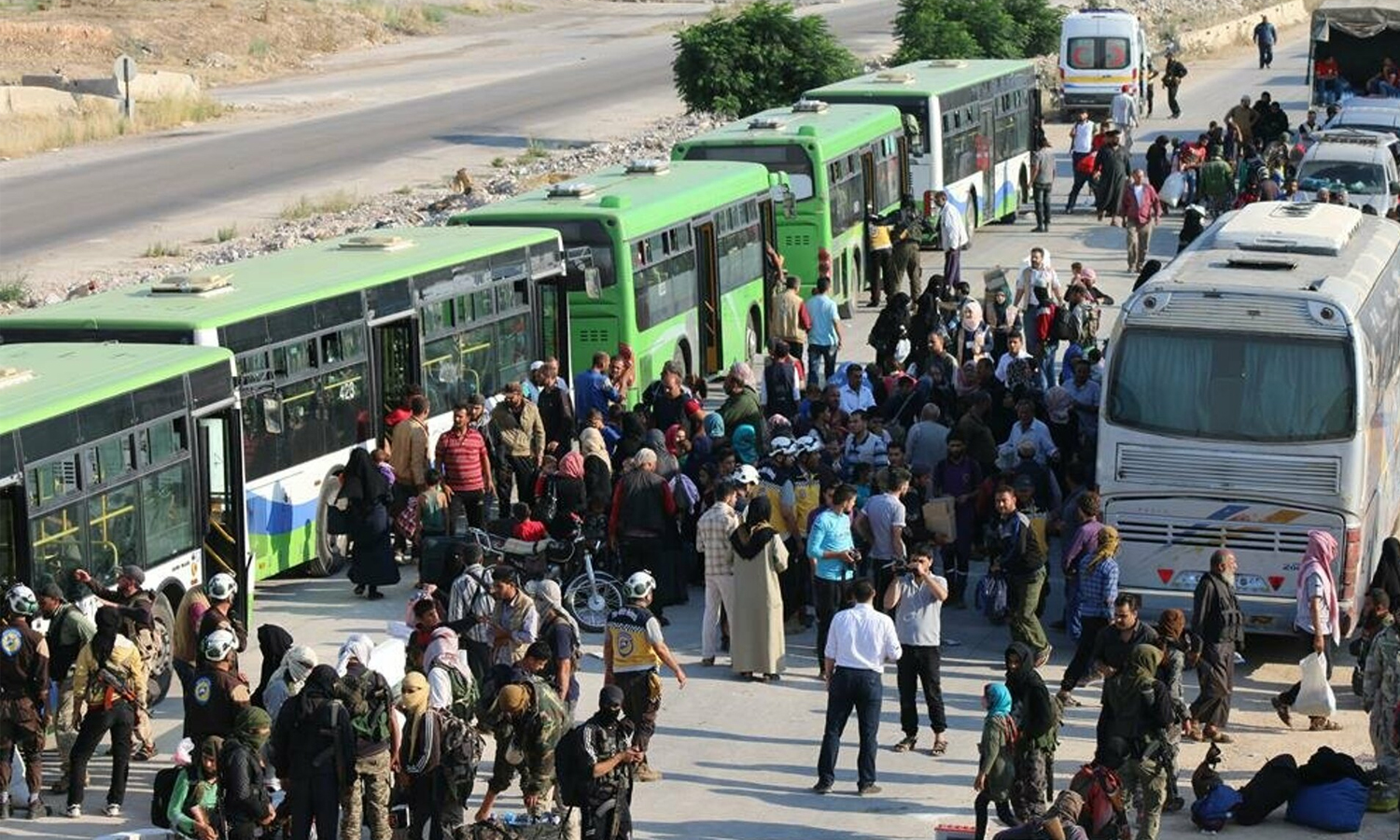
The eviction of families in Quneitra governorate after the settlement agreement – 21 July 2018 (Anadolu Agency)
Failed settlements, Daraa as a model
Daraa governorate is the most prominent example of the instability that formed after the settlement agreements, including security chaos and indiscriminate arrests.
Daraa Martyrs Documentation Office has recorded the killing of 15 civilians and former fighters last January, according to a statement issued early February.
In a separate statement, the local monitoring group said the escalating pace of assassination attempts and operations in Daraa continues despite the second settlement agreement reached three months ago. The first was brokered by Russia in August 2018.
Daraa is under a state of panic due to the spread of kidnapping, with repeated cases aimed at obtaining ransom, most notably the case of the child Fawaz Qutaifan, who was released last week after paying $150,000 ransom.
Political researcher Maan Talaa explains to Enab Baladi the persistence of insecurity in Daraa as an important geopolitical factor in the Syrian scene, even in the context of the reconciliation agreement in 2018, as this province preserved its demographic composition and the diversity of its revolutionary and civil forces, which contributed to keeping Daraa a special case that formed an obstacle to the regime’s vision in those areas.
Talaa considered that even today, when looking at the 2021 settlement, we find that we are facing a repetition of the same scenario of 2018, explaining that despite the increased rates of control by the regime, as long as there are strategic reasons that are absent from the idea of local settlements, it will not remain conducive to stability, but rather will encourage the networks of corruption and the networks of the war economy to grow even more.
One of the factors that contributed to creating instability in the areas that witnessed settlements, is the absence of the Syrian regime’s understanding of the demographic nature of the settlement areas, the most prominent of which was Daraa.
Researcher Aron Lund attributed the reasons for the instability of Daraa to the fact that it still contains remnants of the revolution against the regime, and although it is not necessarily coherent, it shares the same goal.
Lund gave an example that “some local groups have a revolutionary identity, but there are also remnants of the Islamic State in certain areas. There are also armed groups with an unclear or shifting local identity, which may be connected to villages, clans, or communities.”
“In addition, there are groups that work for the government but that are not fully loyal to it and continue to be involved in local conflicts,” he added.
“On the other hand, you also have general non-political unrest. There is a proliferation of weapons and psychological trauma among young men, who have no chance of building a future with a normal job. This is sure to lead to problems in any situation. There are conflicts between individuals or families. There are crimes, smuggling, kidnappings, and so on.”
Part of this chaos is “a legacy of the conflict, but it also arises naturally in the absence of effective security and a functioning economy,” Lund said.
“The lack of a coherent security structure and the tense relationship between local factions and the Syrian government prevent effective civil policing. The desperate economic situation feeds unrest and criminality. Government-aligned armed groups are also deeply involved in crime and smuggling, often contributing to the unrest instead of operating as normal security forces.”
Citizens in Daraa, like other Syrian regions, suffer from severe economic crises, as 90 percent of them live below the poverty line, and 60 percent suffer from a food security deficit, according to United Nations estimates.
The settlement agreements imposed by the regime’s government could not address all these problems, Lund added.
“There are deep-rooted problems that the Assad government struggles to address. Some of these problems are political in nature, including resistance to the regime, whereas others are structural and have to do with the economic and security situation in Deraa,” according to Lund.
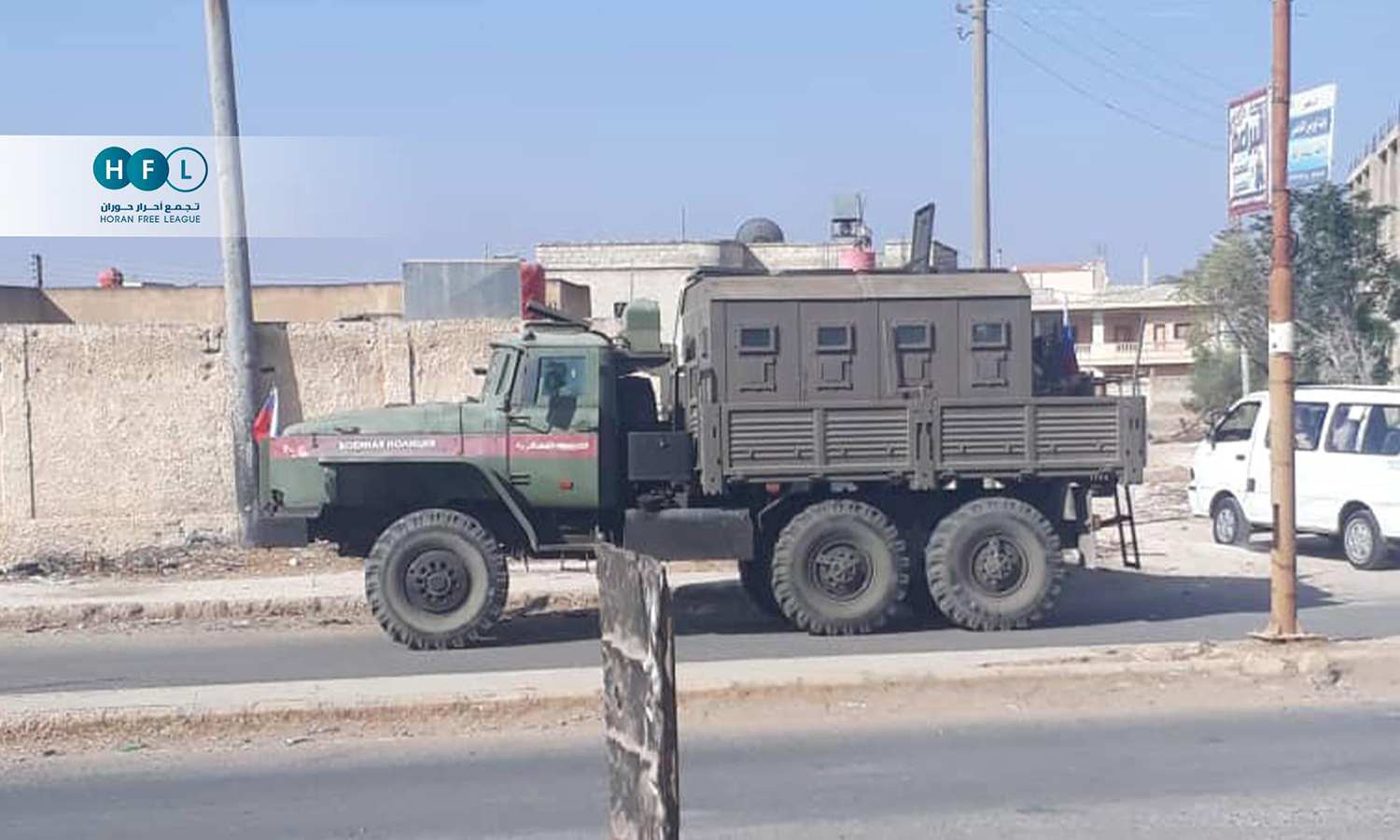
The Russian military police roaming the streets of al-Yadudah city in Daraa countryside to implement the settlement agreement – 13 September 2021 (Ahrar Houran Gathering)
Do settlements’ internal and external paths intersect?
The de-facto settlement strategy follows two parallel lines, the internal settlement track, at the expense of the more comprehensive track, which is the political settlement with the Syrian opposition.
The settlements had had a significant impact as the fruit of a systematic policy of the regime since 2011, when it sought to control areas at the expense of others, according to the strategic value of those areas, which put them in a position of comparison, according to Talaa.
Who controls ground, owns politics
The Syrian regime has emerged with security patterns since the Russian intervention on 30 September 2015 to mitigate the flares of war in order to reach the extension of control and put forward the restored areas as a local model for a comprehensive settlement, reflecting the regime’s vision of conflict resolution mechanisms related to its perspective, which is based on a settlement with military parties that leads to security control on the ground.
After the Geneva peace talks faltered, and then new political tracks were born, most notably the Astana round, which is supported by Russia, Turkey, and Iran, it is clear that the military agent has the final say at any negotiating table, meaning that whoever owns geography has more cards to negotiate, analysts assume.
The internal settlement tracks have not affected or constituted a pressure mechanism on UN and international decisions until the present time, according to Talaa.
The international system is still dealing with the solution as being political, which means the absence of any influence on the political scene. On the contrary, the political proposal has declined from reaching a transitional governing body to forming working groups that discuss non-essential details compared to the opposition’s first proposal, which is replacing the regime.
Researcher Aron Lund, in his turn, does not believe in the existence of a link between the local settlement processes and the political track, whether in Astana or Geneva, noting that every development in Syria has an impact on the political talks, even if it was indirect.
The United Nations Special Envoy for Syria Geir O. Pedersen presented new approaches to the Syrian dilemma, such as “Step-for-Step” and “Changing Regime Behavior,” according to the American concept, or “Restorative Justice,” a term that Pedersen raised in previous briefings, which means “the process in which the victim, offender and, where appropriate, any of the individuals or other members of the community affected by the crime, actively participate in resolving issues arising from the crime, with the assistance of a third party facilitator of that process, whose role is to facilitate the participation of the parties in the process conciliatory, fairly and impartially.
These proposals are based, in Talaa’s opinion, on the margins provided by the intersection of interests of the main actors in the five permanent members of the UN Security Council, which means searching for the engines of the political process outside the field logic that was imposing itself, in line with the inevitably Russian expansion.
Since the “Step-for-Step” approach represents a semi-official declaration of the ineffectiveness of the constitutional process, all of Pedersen’s propositions are nothing more than a move to stagnation and push the political process towards steps that restore its momentum.
The Syrian opposition rejected the Step-for-Step approach on 9 February.
Anas al-Abdah, head of the Syrian Negotiation Committee (SNC), told Enab Baladi that the most important reason for rejecting the approach was because it was “a deviation from the objectives of the political process, specifically the issue of political transition.”
An important part of the reasons for rejecting the Step-for-Step strategy is the lack of clarity on Pedersen’s proposal, he said. Al-Abdah added that the UN envoy wanted the Syrian opposition to granting him a carte blanche without getting any guarantee on where it will lead and how it will end.
Pedersen preserves security path
The most prominent shortcomings of Pedersen’s proposals is that they serve the security context more than any political goal affirmed by international resolutions, which means the absence of any political agenda or ground, in addition to the lack of clarity of who will take the step and what the corresponding step will be, and who will take that step on the other party, and what shape it will take.
Political researcher Maan Talaa says that there is an unclear process of dilution associated with this proposal, which makes it outside its political context.
Speaking of restorative justice, this process gives the victim the opportunity to talk about the crime, and the parties can explain how it affected them, seek assurances that it will not happen again, and agree on how to repair the damage.
The processes that are defined as “restorative” processes may vary by the necessity or desirability of retribution and punishment, the extent to which the affected parties’ participation and interaction are necessary, and the degree of focus on the victims.
Researcher Aron Lund, in turn, calls for not mixing Pedersen’s proposals with the local “compromises” imposed by the Syrian regime in Daraa, Raqqa, and other places, considering the two issues as separate.
Talaa stressed that Pedersen’s proposals suggest that he does not understand the structure of the Syrian regime, which deals with international political proposals and diplomatic initiatives by accepting them shamly, then engaging in them to ensure that they are obstructed before overcoming them. Working according to this mechanism gives the regime time to rearrange its papers again.
These propositions are also based on local settlements without understanding their impact on the local reality, which is manifested by security control, arrests, displacement, and the removal of areas from development rates, as happened in Eastern Ghouta and Eastern Aleppo, and the regime treated these areas as “hot spots” that are not safe in the foreseeable future.
All of the above confirms that Pedersen’s proposals and endeavors to reach a settlement do not go beyond getting rid of the fluidity of the Syrian political scene, and this reveals the circumvention of the idea of international inability in serious political proposals that oblige the regime to engage in a transitional process and to kill the idea of political transition as a whole, which is in the interest of the regime and its allies, according to Talaa.
if you think the article contain wrong information or you have additional details Send Correction
النسخة العربية من المقال
-
Follow us :













 Security and military settlements for the people of Deir Ezzor governorate, eastern Syria (edited by Enab Baladi)
Security and military settlements for the people of Deir Ezzor governorate, eastern Syria (edited by Enab Baladi)





 A
A
A
A
A
A
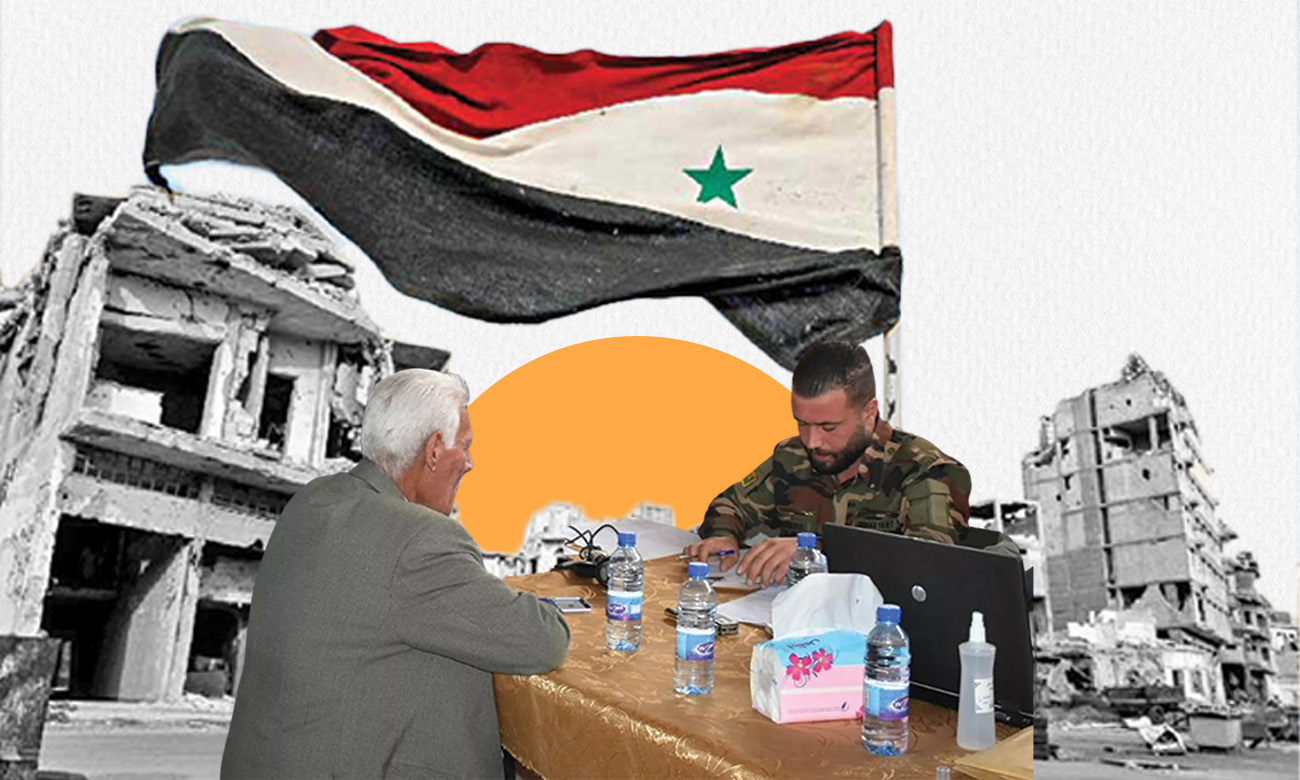
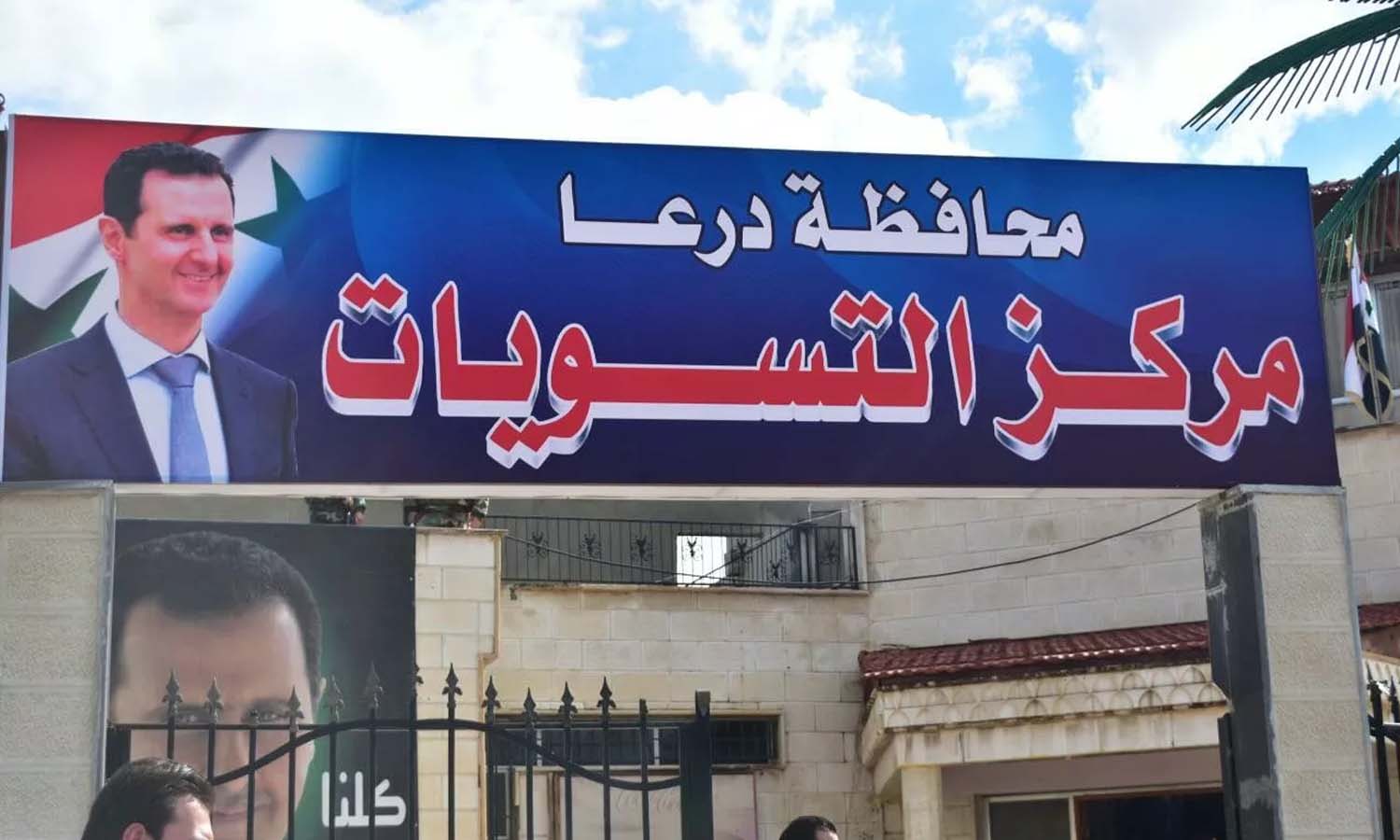








 More In-Depth
More In-Depth